ATHC1: Clinical Reasoning, Assessment, and Therapeutic Care Report
VerifiedAdded on 2023/03/21
|8
|1913
|23
Report
AI Summary
This report presents a clinical reasoning assessment of Mr. Cyril Smith, a 72-year-old patient admitted for bowel cancer surgery. The assessment includes a review of his medical history, current observations, and an analysis of relevant cues and information. Key issues identified include dehydration, potential hyperglycaemia, and elevated respiratory and pulse rates, possibly exacerbated by stress and recent personal losses. The report also addresses critical thinking questions related to safe medication practices, the importance of therapeutic communication in person-centered care, and reflections on the learning experience, emphasizing the importance of family involvement and behavioural therapy in managing elderly patients' conditions. The student nurse outlines future actions to monitor vitals, administer fluid challenges, and notify the doctor of any concerns.
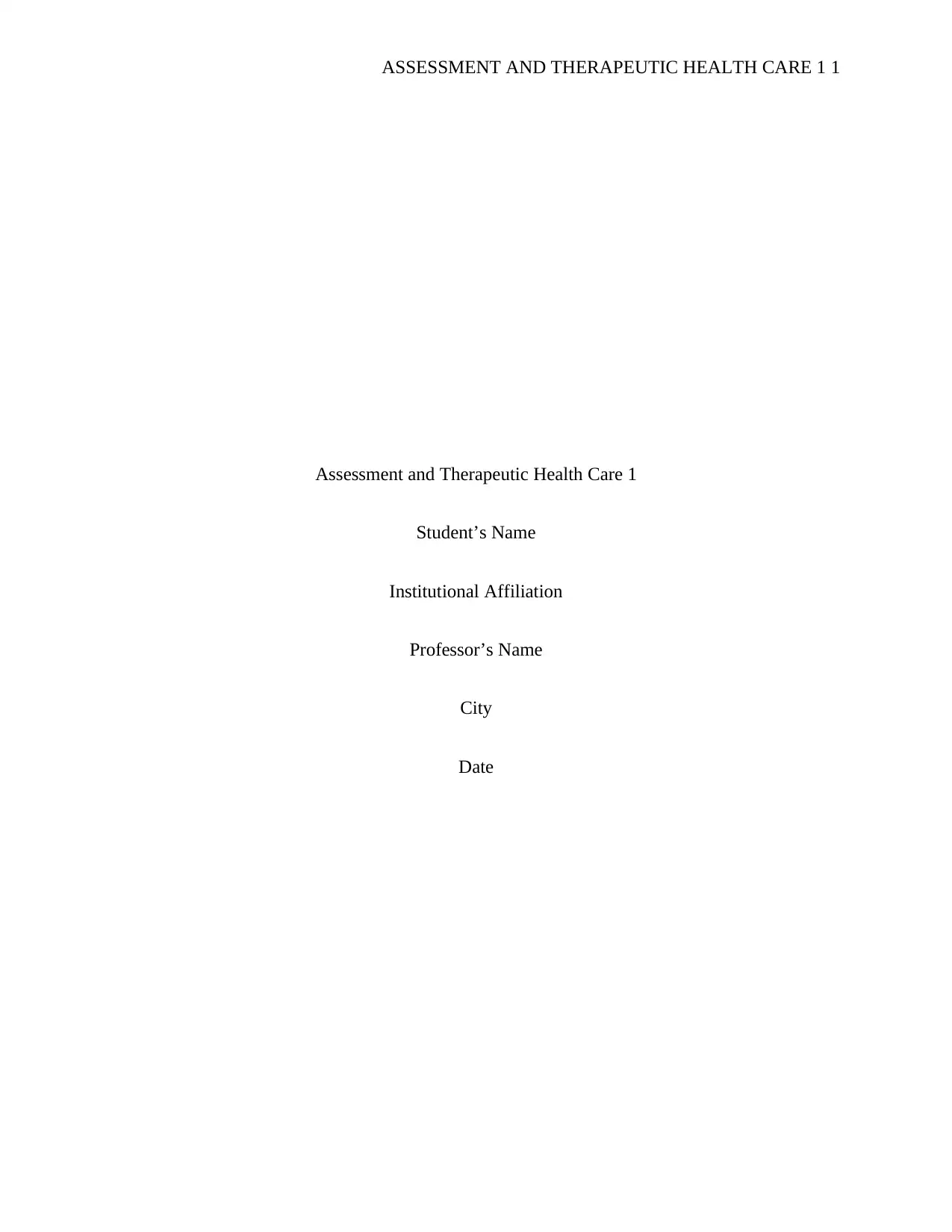
ASSESSMENT AND THERAPEUTIC HEALTH CARE 1 1
Assessment and Therapeutic Health Care 1
Student’s Name
Institutional Affiliation
Professor’s Name
City
Date
Assessment and Therapeutic Health Care 1
Student’s Name
Institutional Affiliation
Professor’s Name
City
Date
Paraphrase This Document
Need a fresh take? Get an instant paraphrase of this document with our AI Paraphraser
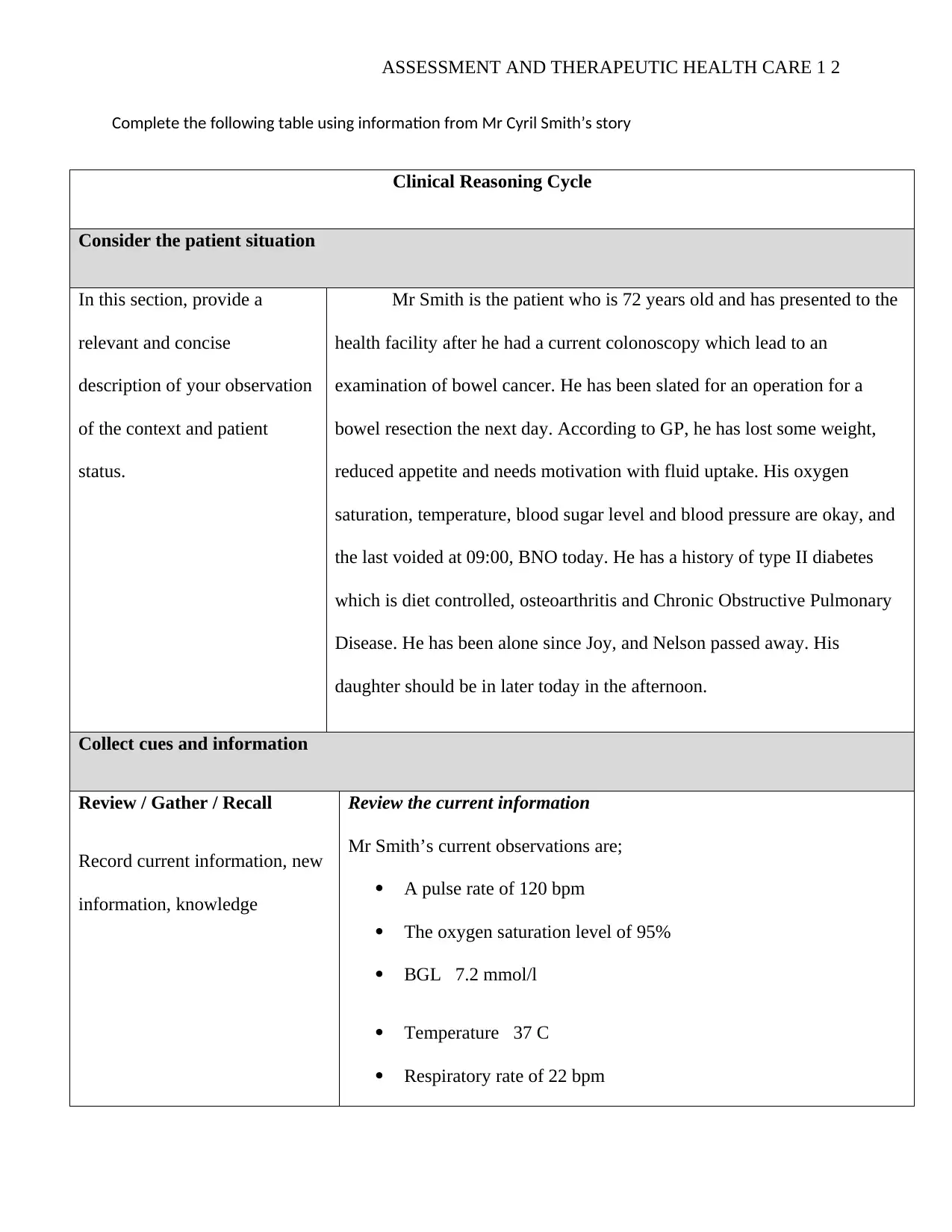
ASSESSMENT AND THERAPEUTIC HEALTH CARE 1 2
Complete the following table using information from Mr Cyril Smith’s story
Clinical Reasoning Cycle
Consider the patient situation
In this section, provide a
relevant and concise
description of your observation
of the context and patient
status.
Mr Smith is the patient who is 72 years old and has presented to the
health facility after he had a current colonoscopy which lead to an
examination of bowel cancer. He has been slated for an operation for a
bowel resection the next day. According to GP, he has lost some weight,
reduced appetite and needs motivation with fluid uptake. His oxygen
saturation, temperature, blood sugar level and blood pressure are okay, and
the last voided at 09:00, BNO today. He has a history of type II diabetes
which is diet controlled, osteoarthritis and Chronic Obstructive Pulmonary
Disease. He has been alone since Joy, and Nelson passed away. His
daughter should be in later today in the afternoon.
Collect cues and information
Review / Gather / Recall
Record current information, new
information, knowledge
Review the current information
Mr Smith’s current observations are;
A pulse rate of 120 bpm
The oxygen saturation level of 95%
BGL 7.2 mmol/l
Temperature 37 C
Respiratory rate of 22 bpm
Complete the following table using information from Mr Cyril Smith’s story
Clinical Reasoning Cycle
Consider the patient situation
In this section, provide a
relevant and concise
description of your observation
of the context and patient
status.
Mr Smith is the patient who is 72 years old and has presented to the
health facility after he had a current colonoscopy which lead to an
examination of bowel cancer. He has been slated for an operation for a
bowel resection the next day. According to GP, he has lost some weight,
reduced appetite and needs motivation with fluid uptake. His oxygen
saturation, temperature, blood sugar level and blood pressure are okay, and
the last voided at 09:00, BNO today. He has a history of type II diabetes
which is diet controlled, osteoarthritis and Chronic Obstructive Pulmonary
Disease. He has been alone since Joy, and Nelson passed away. His
daughter should be in later today in the afternoon.
Collect cues and information
Review / Gather / Recall
Record current information, new
information, knowledge
Review the current information
Mr Smith’s current observations are;
A pulse rate of 120 bpm
The oxygen saturation level of 95%
BGL 7.2 mmol/l
Temperature 37 C
Respiratory rate of 22 bpm
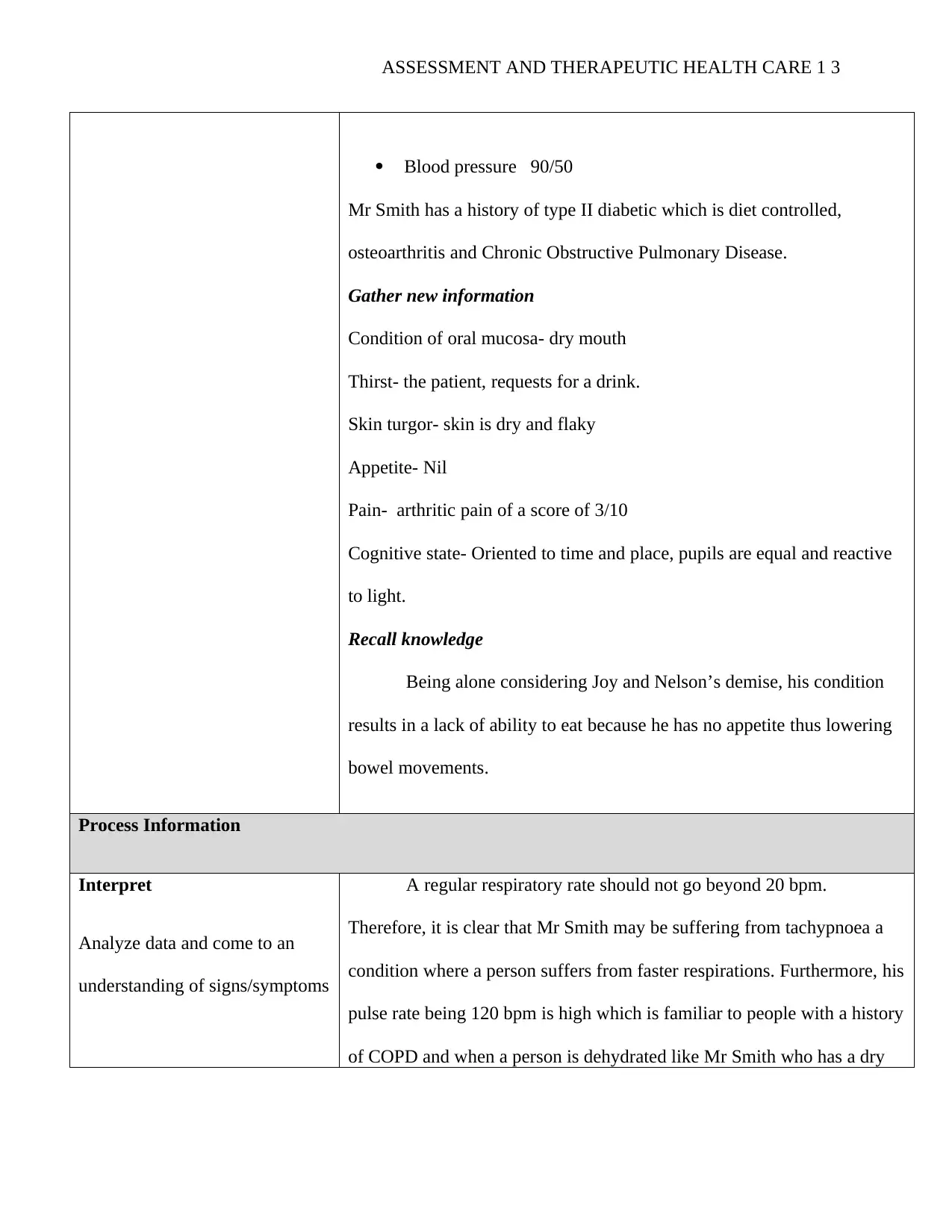
ASSESSMENT AND THERAPEUTIC HEALTH CARE 1 3
Blood pressure 90/50
Mr Smith has a history of type II diabetic which is diet controlled,
osteoarthritis and Chronic Obstructive Pulmonary Disease.
Gather new information
Condition of oral mucosa- dry mouth
Thirst- the patient, requests for a drink.
Skin turgor- skin is dry and flaky
Appetite- Nil
Pain- arthritic pain of a score of 3/10
Cognitive state- Oriented to time and place, pupils are equal and reactive
to light.
Recall knowledge
Being alone considering Joy and Nelson’s demise, his condition
results in a lack of ability to eat because he has no appetite thus lowering
bowel movements.
Process Information
Interpret
Analyze data and come to an
understanding of signs/symptoms
A regular respiratory rate should not go beyond 20 bpm.
Therefore, it is clear that Mr Smith may be suffering from tachypnoea a
condition where a person suffers from faster respirations. Furthermore, his
pulse rate being 120 bpm is high which is familiar to people with a history
of COPD and when a person is dehydrated like Mr Smith who has a dry
Blood pressure 90/50
Mr Smith has a history of type II diabetic which is diet controlled,
osteoarthritis and Chronic Obstructive Pulmonary Disease.
Gather new information
Condition of oral mucosa- dry mouth
Thirst- the patient, requests for a drink.
Skin turgor- skin is dry and flaky
Appetite- Nil
Pain- arthritic pain of a score of 3/10
Cognitive state- Oriented to time and place, pupils are equal and reactive
to light.
Recall knowledge
Being alone considering Joy and Nelson’s demise, his condition
results in a lack of ability to eat because he has no appetite thus lowering
bowel movements.
Process Information
Interpret
Analyze data and come to an
understanding of signs/symptoms
A regular respiratory rate should not go beyond 20 bpm.
Therefore, it is clear that Mr Smith may be suffering from tachypnoea a
condition where a person suffers from faster respirations. Furthermore, his
pulse rate being 120 bpm is high which is familiar to people with a history
of COPD and when a person is dehydrated like Mr Smith who has a dry
⊘ This is a preview!⊘
Do you want full access?
Subscribe today to unlock all pages.

Trusted by 1+ million students worldwide

ASSESSMENT AND THERAPEUTIC HEALTH CARE 1 4
mouth.
Discriminate
Distinguish relevant from
irrelevant information
Mr Smith’s breathing rate is up a bit, but I am not worried about it.
Nevertheless, more concern is directed towards the pulse rate. For that
reason, it is good to check the oxygen saturation in the blood since when
the heart is beating quicker; the heart muscles need more oxygen. If it
prevails, oxygen-starved myocardial cells may die leading to a stroke.
Relate & Infer
Cluster cues, make deductions or
form opinions
Relate
Mr Smith’s high breathing rate along with high pulse rate might
result in a heart condition. Moreover, his usual medications prove that the
mentioned comorbidities of type 2 diabetes, osteoarthritis, and COPD.
The dry and flaky skin may have resulted because of type 2 diabetes.
Infer
In Mr Smith’s case, his respiratory rate and pulse rate could be
higher depending on the stress and tension he has been exposed to in his
old age since the demise of his wife and son.
Match
Match current situation to past
situations
Older people like Mr Smith are at peril of suffering from type II
Diabetes and bowel cancer. For that reason, some of the challenges that he
experience are connected. Moreover, as people get older, their body
muscles become weaker and which exposes them to risks of fractures. The
arthritic pain that Mr Smith says he experiences may be originating from
the ankle fracture he experienced 15 years ago.
Predict Based on Mr Smith's nature, if he is not taken for X-ray scan,
mouth.
Discriminate
Distinguish relevant from
irrelevant information
Mr Smith’s breathing rate is up a bit, but I am not worried about it.
Nevertheless, more concern is directed towards the pulse rate. For that
reason, it is good to check the oxygen saturation in the blood since when
the heart is beating quicker; the heart muscles need more oxygen. If it
prevails, oxygen-starved myocardial cells may die leading to a stroke.
Relate & Infer
Cluster cues, make deductions or
form opinions
Relate
Mr Smith’s high breathing rate along with high pulse rate might
result in a heart condition. Moreover, his usual medications prove that the
mentioned comorbidities of type 2 diabetes, osteoarthritis, and COPD.
The dry and flaky skin may have resulted because of type 2 diabetes.
Infer
In Mr Smith’s case, his respiratory rate and pulse rate could be
higher depending on the stress and tension he has been exposed to in his
old age since the demise of his wife and son.
Match
Match current situation to past
situations
Older people like Mr Smith are at peril of suffering from type II
Diabetes and bowel cancer. For that reason, some of the challenges that he
experience are connected. Moreover, as people get older, their body
muscles become weaker and which exposes them to risks of fractures. The
arthritic pain that Mr Smith says he experiences may be originating from
the ankle fracture he experienced 15 years ago.
Predict Based on Mr Smith's nature, if he is not taken for X-ray scan,
Paraphrase This Document
Need a fresh take? Get an instant paraphrase of this document with our AI Paraphraser
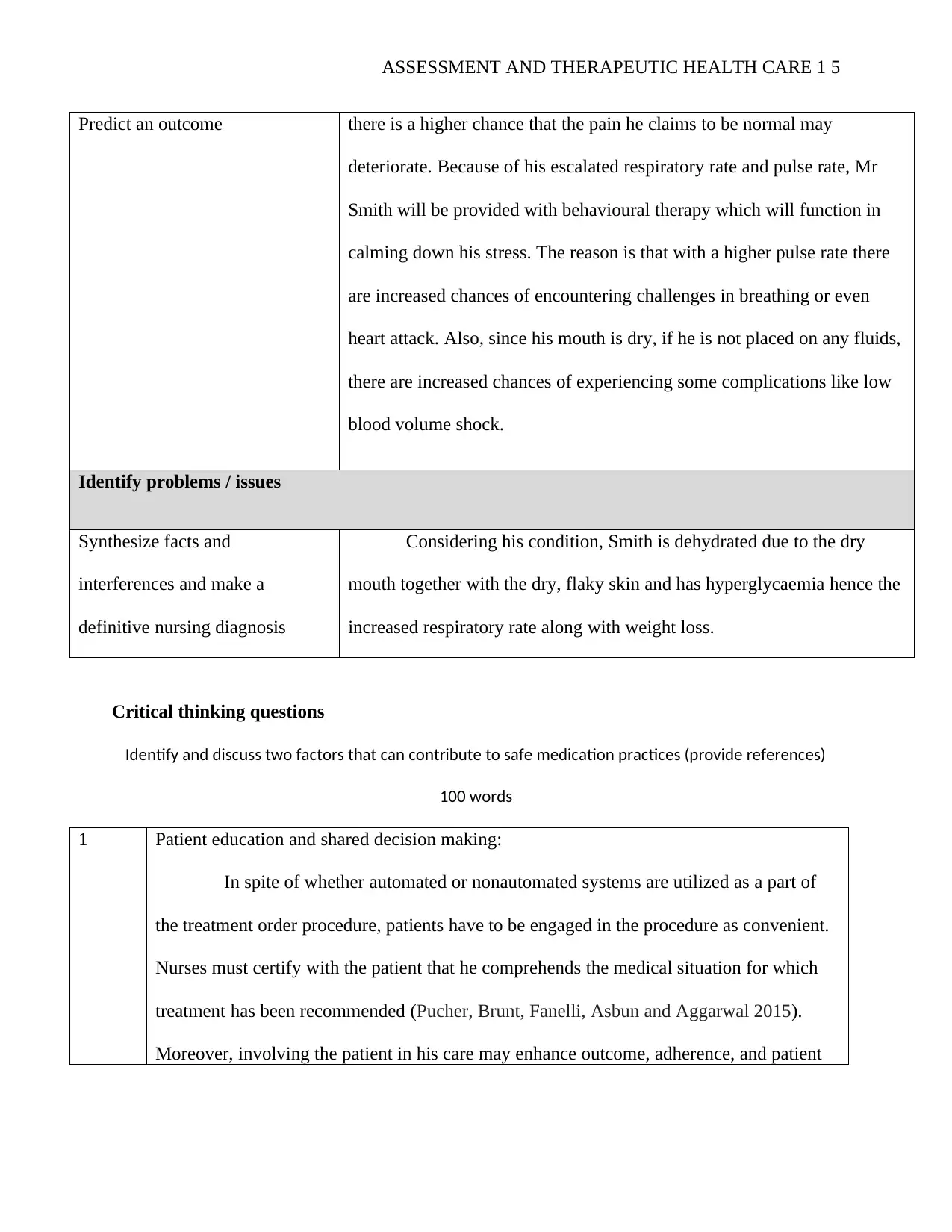
ASSESSMENT AND THERAPEUTIC HEALTH CARE 1 5
Predict an outcome there is a higher chance that the pain he claims to be normal may
deteriorate. Because of his escalated respiratory rate and pulse rate, Mr
Smith will be provided with behavioural therapy which will function in
calming down his stress. The reason is that with a higher pulse rate there
are increased chances of encountering challenges in breathing or even
heart attack. Also, since his mouth is dry, if he is not placed on any fluids,
there are increased chances of experiencing some complications like low
blood volume shock.
Identify problems / issues
Synthesize facts and
interferences and make a
definitive nursing diagnosis
Considering his condition, Smith is dehydrated due to the dry
mouth together with the dry, flaky skin and has hyperglycaemia hence the
increased respiratory rate along with weight loss.
Critical thinking questions
Identify and discuss two factors that can contribute to safe medication practices (provide references)
100 words
1 Patient education and shared decision making:
In spite of whether automated or nonautomated systems are utilized as a part of
the treatment order procedure, patients have to be engaged in the procedure as convenient.
Nurses must certify with the patient that he comprehends the medical situation for which
treatment has been recommended (Pucher, Brunt, Fanelli, Asbun and Aggarwal 2015).
Moreover, involving the patient in his care may enhance outcome, adherence, and patient
Predict an outcome there is a higher chance that the pain he claims to be normal may
deteriorate. Because of his escalated respiratory rate and pulse rate, Mr
Smith will be provided with behavioural therapy which will function in
calming down his stress. The reason is that with a higher pulse rate there
are increased chances of encountering challenges in breathing or even
heart attack. Also, since his mouth is dry, if he is not placed on any fluids,
there are increased chances of experiencing some complications like low
blood volume shock.
Identify problems / issues
Synthesize facts and
interferences and make a
definitive nursing diagnosis
Considering his condition, Smith is dehydrated due to the dry
mouth together with the dry, flaky skin and has hyperglycaemia hence the
increased respiratory rate along with weight loss.
Critical thinking questions
Identify and discuss two factors that can contribute to safe medication practices (provide references)
100 words
1 Patient education and shared decision making:
In spite of whether automated or nonautomated systems are utilized as a part of
the treatment order procedure, patients have to be engaged in the procedure as convenient.
Nurses must certify with the patient that he comprehends the medical situation for which
treatment has been recommended (Pucher, Brunt, Fanelli, Asbun and Aggarwal 2015).
Moreover, involving the patient in his care may enhance outcome, adherence, and patient
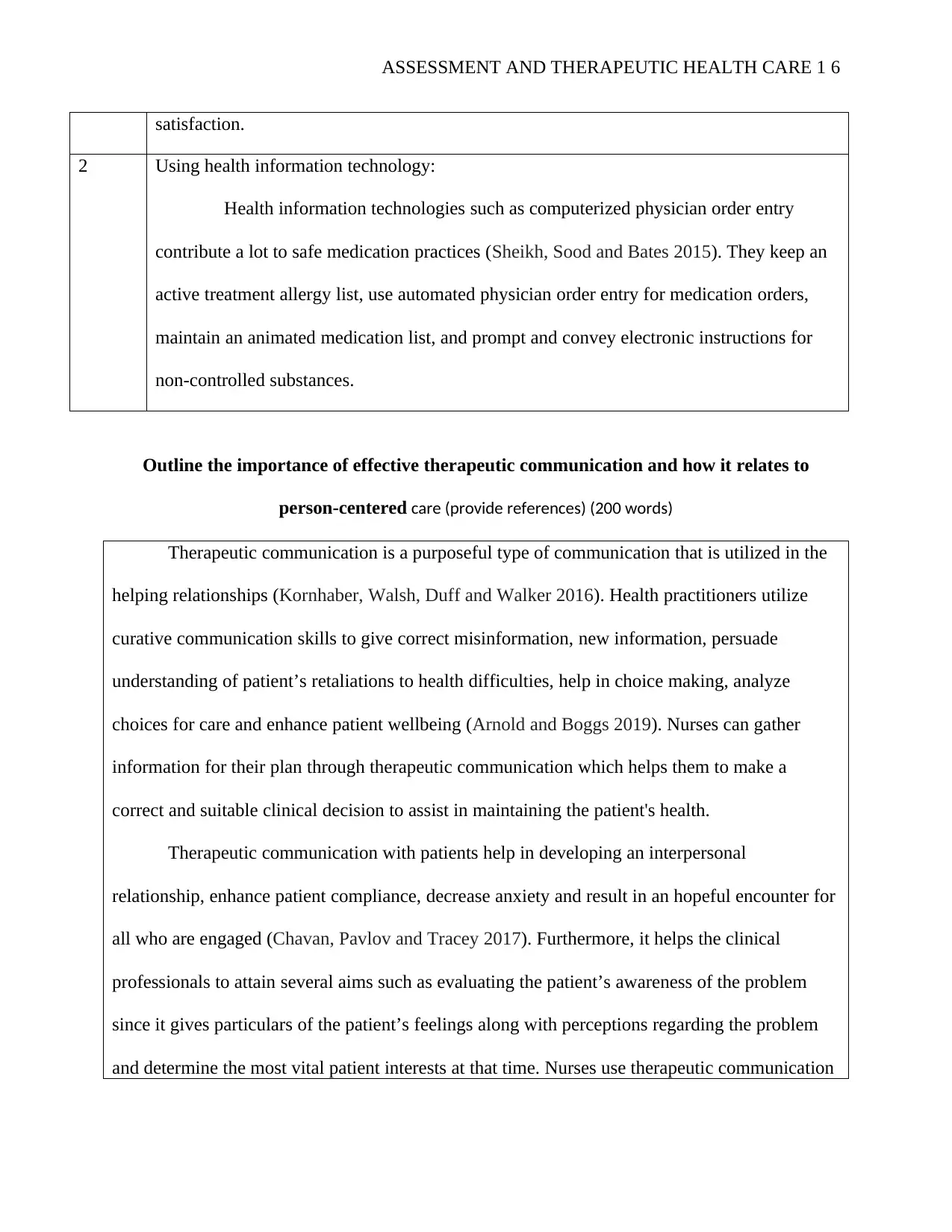
ASSESSMENT AND THERAPEUTIC HEALTH CARE 1 6
satisfaction.
2 Using health information technology:
Health information technologies such as computerized physician order entry
contribute a lot to safe medication practices (Sheikh, Sood and Bates 2015). They keep an
active treatment allergy list, use automated physician order entry for medication orders,
maintain an animated medication list, and prompt and convey electronic instructions for
non-controlled substances.
Outline the importance of effective therapeutic communication and how it relates to
person-centered care (provide references) (200 words)
Therapeutic communication is a purposeful type of communication that is utilized in the
helping relationships (Kornhaber, Walsh, Duff and Walker 2016). Health practitioners utilize
curative communication skills to give correct misinformation, new information, persuade
understanding of patient’s retaliations to health difficulties, help in choice making, analyze
choices for care and enhance patient wellbeing (Arnold and Boggs 2019). Nurses can gather
information for their plan through therapeutic communication which helps them to make a
correct and suitable clinical decision to assist in maintaining the patient's health.
Therapeutic communication with patients help in developing an interpersonal
relationship, enhance patient compliance, decrease anxiety and result in an hopeful encounter for
all who are engaged (Chavan, Pavlov and Tracey 2017). Furthermore, it helps the clinical
professionals to attain several aims such as evaluating the patient’s awareness of the problem
since it gives particulars of the patient’s feelings along with perceptions regarding the problem
and determine the most vital patient interests at that time. Nurses use therapeutic communication
satisfaction.
2 Using health information technology:
Health information technologies such as computerized physician order entry
contribute a lot to safe medication practices (Sheikh, Sood and Bates 2015). They keep an
active treatment allergy list, use automated physician order entry for medication orders,
maintain an animated medication list, and prompt and convey electronic instructions for
non-controlled substances.
Outline the importance of effective therapeutic communication and how it relates to
person-centered care (provide references) (200 words)
Therapeutic communication is a purposeful type of communication that is utilized in the
helping relationships (Kornhaber, Walsh, Duff and Walker 2016). Health practitioners utilize
curative communication skills to give correct misinformation, new information, persuade
understanding of patient’s retaliations to health difficulties, help in choice making, analyze
choices for care and enhance patient wellbeing (Arnold and Boggs 2019). Nurses can gather
information for their plan through therapeutic communication which helps them to make a
correct and suitable clinical decision to assist in maintaining the patient's health.
Therapeutic communication with patients help in developing an interpersonal
relationship, enhance patient compliance, decrease anxiety and result in an hopeful encounter for
all who are engaged (Chavan, Pavlov and Tracey 2017). Furthermore, it helps the clinical
professionals to attain several aims such as evaluating the patient’s awareness of the problem
since it gives particulars of the patient’s feelings along with perceptions regarding the problem
and determine the most vital patient interests at that time. Nurses use therapeutic communication
⊘ This is a preview!⊘
Do you want full access?
Subscribe today to unlock all pages.

Trusted by 1+ million students worldwide
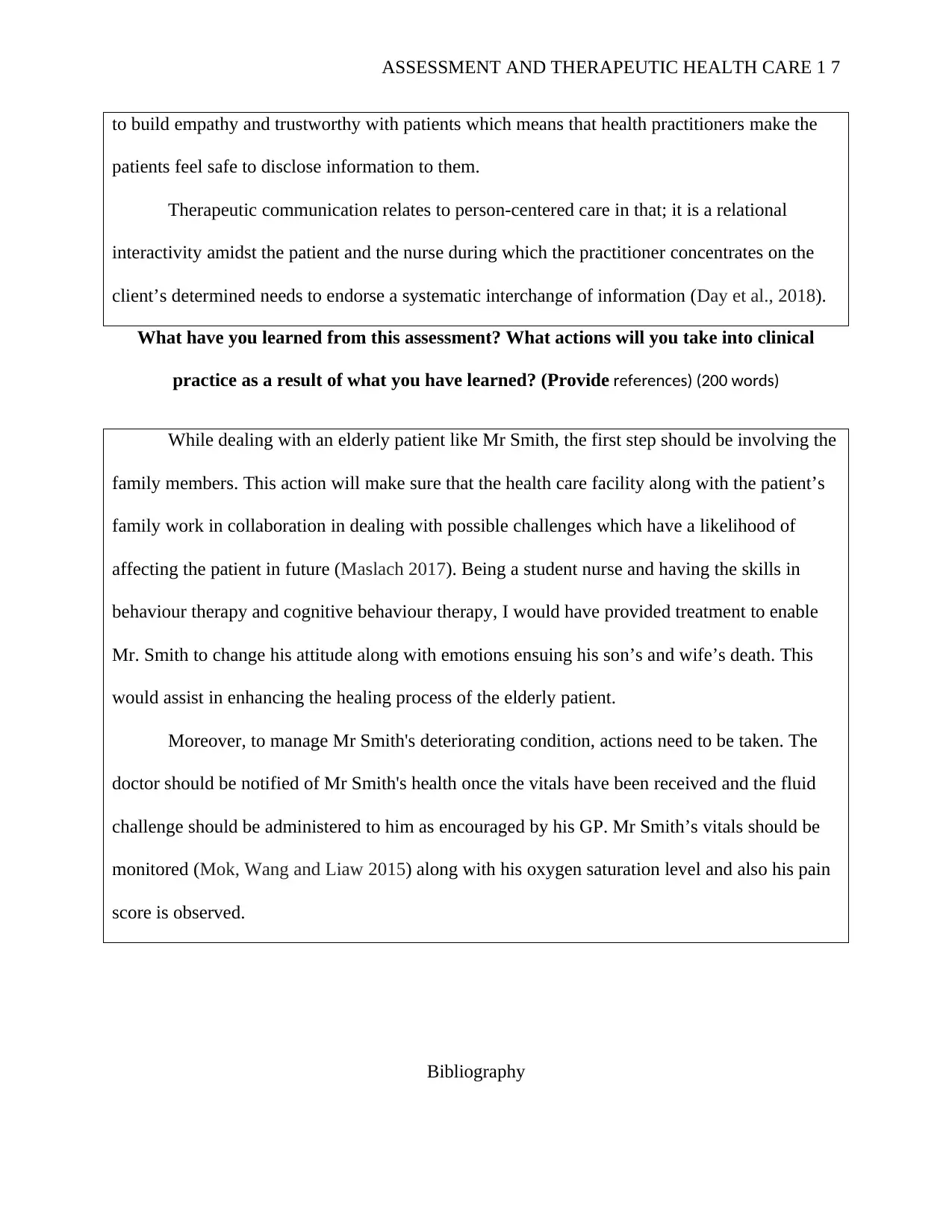
ASSESSMENT AND THERAPEUTIC HEALTH CARE 1 7
to build empathy and trustworthy with patients which means that health practitioners make the
patients feel safe to disclose information to them.
Therapeutic communication relates to person-centered care in that; it is a relational
interactivity amidst the patient and the nurse during which the practitioner concentrates on the
client’s determined needs to endorse a systematic interchange of information (Day et al., 2018).
What have you learned from this assessment? What actions will you take into clinical
practice as a result of what you have learned? (Provide references) (200 words)
While dealing with an elderly patient like Mr Smith, the first step should be involving the
family members. This action will make sure that the health care facility along with the patient’s
family work in collaboration in dealing with possible challenges which have a likelihood of
affecting the patient in future (Maslach 2017). Being a student nurse and having the skills in
behaviour therapy and cognitive behaviour therapy, I would have provided treatment to enable
Mr. Smith to change his attitude along with emotions ensuing his son’s and wife’s death. This
would assist in enhancing the healing process of the elderly patient.
Moreover, to manage Mr Smith's deteriorating condition, actions need to be taken. The
doctor should be notified of Mr Smith's health once the vitals have been received and the fluid
challenge should be administered to him as encouraged by his GP. Mr Smith’s vitals should be
monitored (Mok, Wang and Liaw 2015) along with his oxygen saturation level and also his pain
score is observed.
Bibliography
to build empathy and trustworthy with patients which means that health practitioners make the
patients feel safe to disclose information to them.
Therapeutic communication relates to person-centered care in that; it is a relational
interactivity amidst the patient and the nurse during which the practitioner concentrates on the
client’s determined needs to endorse a systematic interchange of information (Day et al., 2018).
What have you learned from this assessment? What actions will you take into clinical
practice as a result of what you have learned? (Provide references) (200 words)
While dealing with an elderly patient like Mr Smith, the first step should be involving the
family members. This action will make sure that the health care facility along with the patient’s
family work in collaboration in dealing with possible challenges which have a likelihood of
affecting the patient in future (Maslach 2017). Being a student nurse and having the skills in
behaviour therapy and cognitive behaviour therapy, I would have provided treatment to enable
Mr. Smith to change his attitude along with emotions ensuing his son’s and wife’s death. This
would assist in enhancing the healing process of the elderly patient.
Moreover, to manage Mr Smith's deteriorating condition, actions need to be taken. The
doctor should be notified of Mr Smith's health once the vitals have been received and the fluid
challenge should be administered to him as encouraged by his GP. Mr Smith’s vitals should be
monitored (Mok, Wang and Liaw 2015) along with his oxygen saturation level and also his pain
score is observed.
Bibliography
Paraphrase This Document
Need a fresh take? Get an instant paraphrase of this document with our AI Paraphraser
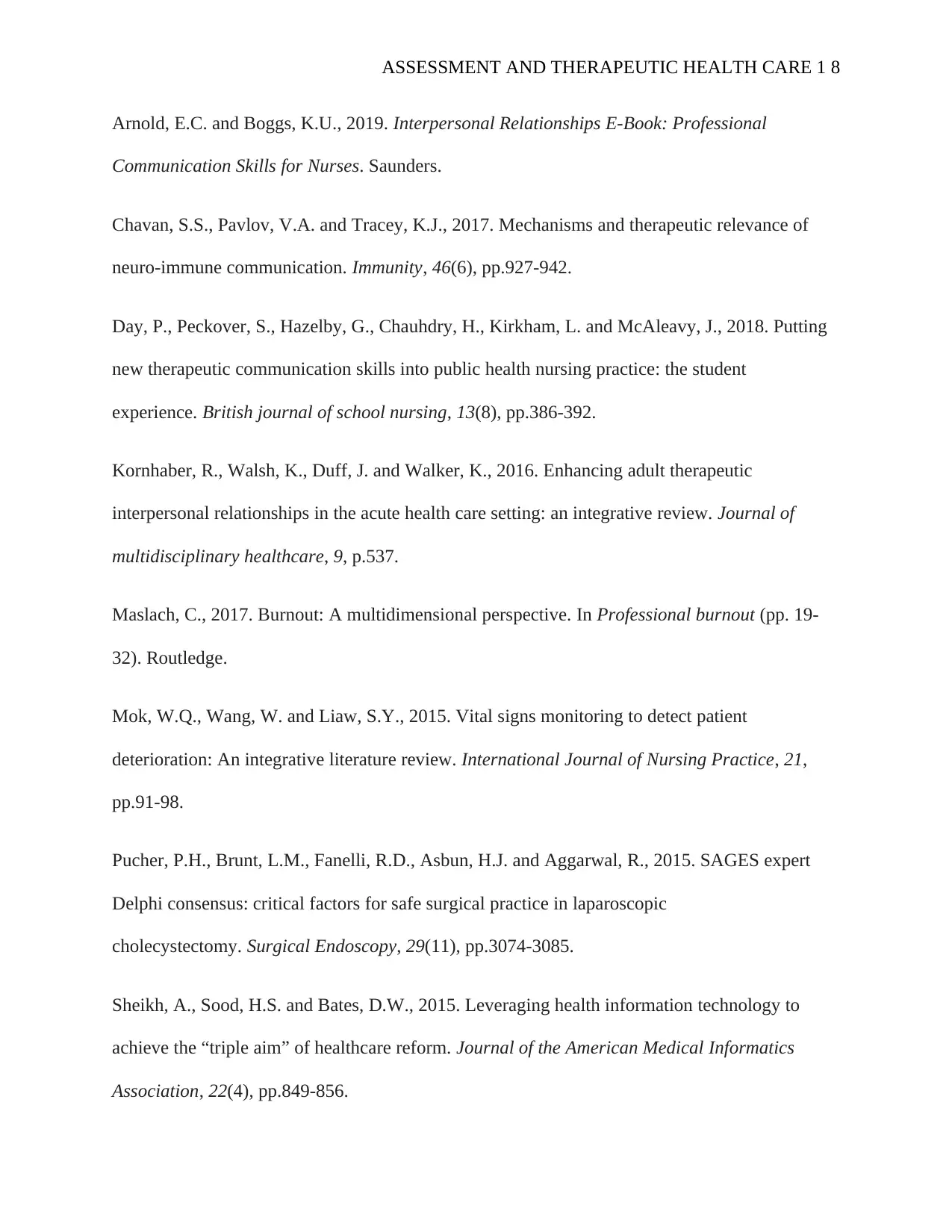
ASSESSMENT AND THERAPEUTIC HEALTH CARE 1 8
Arnold, E.C. and Boggs, K.U., 2019. Interpersonal Relationships E-Book: Professional
Communication Skills for Nurses. Saunders.
Chavan, S.S., Pavlov, V.A. and Tracey, K.J., 2017. Mechanisms and therapeutic relevance of
neuro-immune communication. Immunity, 46(6), pp.927-942.
Day, P., Peckover, S., Hazelby, G., Chauhdry, H., Kirkham, L. and McAleavy, J., 2018. Putting
new therapeutic communication skills into public health nursing practice: the student
experience. British journal of school nursing, 13(8), pp.386-392.
Kornhaber, R., Walsh, K., Duff, J. and Walker, K., 2016. Enhancing adult therapeutic
interpersonal relationships in the acute health care setting: an integrative review. Journal of
multidisciplinary healthcare, 9, p.537.
Maslach, C., 2017. Burnout: A multidimensional perspective. In Professional burnout (pp. 19-
32). Routledge.
Mok, W.Q., Wang, W. and Liaw, S.Y., 2015. Vital signs monitoring to detect patient
deterioration: An integrative literature review. International Journal of Nursing Practice, 21,
pp.91-98.
Pucher, P.H., Brunt, L.M., Fanelli, R.D., Asbun, H.J. and Aggarwal, R., 2015. SAGES expert
Delphi consensus: critical factors for safe surgical practice in laparoscopic
cholecystectomy. Surgical Endoscopy, 29(11), pp.3074-3085.
Sheikh, A., Sood, H.S. and Bates, D.W., 2015. Leveraging health information technology to
achieve the “triple aim” of healthcare reform. Journal of the American Medical Informatics
Association, 22(4), pp.849-856.
Arnold, E.C. and Boggs, K.U., 2019. Interpersonal Relationships E-Book: Professional
Communication Skills for Nurses. Saunders.
Chavan, S.S., Pavlov, V.A. and Tracey, K.J., 2017. Mechanisms and therapeutic relevance of
neuro-immune communication. Immunity, 46(6), pp.927-942.
Day, P., Peckover, S., Hazelby, G., Chauhdry, H., Kirkham, L. and McAleavy, J., 2018. Putting
new therapeutic communication skills into public health nursing practice: the student
experience. British journal of school nursing, 13(8), pp.386-392.
Kornhaber, R., Walsh, K., Duff, J. and Walker, K., 2016. Enhancing adult therapeutic
interpersonal relationships in the acute health care setting: an integrative review. Journal of
multidisciplinary healthcare, 9, p.537.
Maslach, C., 2017. Burnout: A multidimensional perspective. In Professional burnout (pp. 19-
32). Routledge.
Mok, W.Q., Wang, W. and Liaw, S.Y., 2015. Vital signs monitoring to detect patient
deterioration: An integrative literature review. International Journal of Nursing Practice, 21,
pp.91-98.
Pucher, P.H., Brunt, L.M., Fanelli, R.D., Asbun, H.J. and Aggarwal, R., 2015. SAGES expert
Delphi consensus: critical factors for safe surgical practice in laparoscopic
cholecystectomy. Surgical Endoscopy, 29(11), pp.3074-3085.
Sheikh, A., Sood, H.S. and Bates, D.W., 2015. Leveraging health information technology to
achieve the “triple aim” of healthcare reform. Journal of the American Medical Informatics
Association, 22(4), pp.849-856.
1 out of 8
Related Documents
Your All-in-One AI-Powered Toolkit for Academic Success.
+13062052269
info@desklib.com
Available 24*7 on WhatsApp / Email
![[object Object]](/_next/static/media/star-bottom.7253800d.svg)
Unlock your academic potential
Copyright © 2020–2026 A2Z Services. All Rights Reserved. Developed and managed by ZUCOL.





